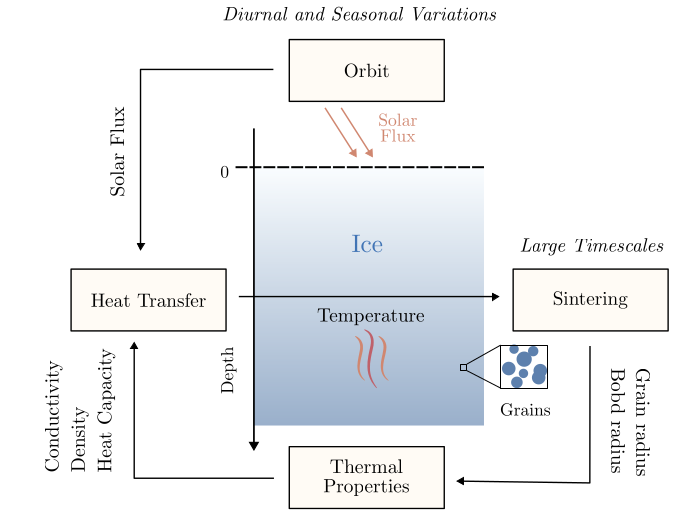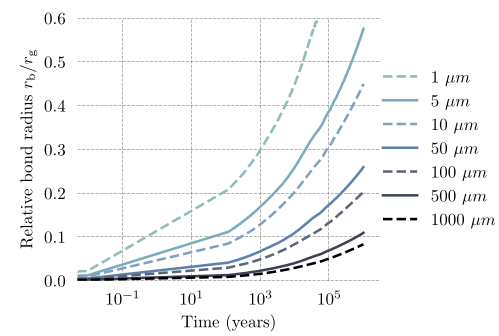Active Sintering on Europa Over a Million-Year Timescale
- 1Université Paris-Saclay, GEOPS, UMR 8146, CNRS, France (cyril.mergny@universite-paris-saclay.fr)
- 2Institut Universitaire de France, Paris, France
Introduction
The surface of icy moons has a microstructure shaped by a complex interplay of physical processes. Among them, ice sintering, also known as annealing or metamorphism, transports material from ice grains into their bond region, resulting in changes in the thermal, optical and mechanical properties of the ice. This study represents the first attempt in planetary science to examine the coupled interaction between heat transfer and sintering. Our approach to ice sintering is based upon the literature, while offering a refined description of the matter exchange between grains, bonds, and the pore space.
A multiphysics simulation model “LunaIcy” incorporating the sintering process coupled with the MultIHeaTS thermal solver, was developed to study the evolution of ice microstructure on Galilean satellites, specifically tracking the changes in the ice grain and bond radii over time. LunaIcy was applied to the evolution of Europa's ice microstructure over a million years along its orbit, with a parameter exploration to investigate the diverse configurations of the icy surface. Our results indicate that effective sintering can take place in regions where daily temperatures briefly surpass 115 K, even during short intervals of the day. Such sintering could not have been detected without the diurnal thermal coupling of LunaIcy, due to the cold daily mean temperature. In these regions, sintering occurs within timescales shorter than Europa's ice crust age, suggesting that, in present times, their surface is made of an interconnected ice structure.
Methods
To accurately simulate the temperature-dependent sintering process, the sintering model is coupled with the thermal solver MultIHeaTS (Mergny 2024a) creating our multiphysics simulation model, LunaIcy (Mergny 2024b) as shown in Figure 1.
MultIHeaTS - Thermal solver
We have developed an efficient open-source fully implicit algorithm called MultIHeaTS, which uses finite differences to solve the heat equation on 1D heterogeneous media with an irregular grid. Due to its stability, MultIHeaTS can compute the same temperature for a given time up to 100 times faster than the explicit method. This is particularly advantageous for simulating processes that occur on large timescales. Thanks to such fast computation, MultIHeaTS is used to estimate the temperature profile on Europa during one million years with varying orbital parameters, allowing us to obtain the full temperature history (Mergny et al, 2024a).
LunaIcy - Sintering model
Previous sintering models used in planetary science, directly compute the mass flux from the grain surface to the bond surface, as it was suggested by (Swinkels 1981). However this difference of curvature between the grains and bonds, does not appear in any of the analytical models of sintering used on Earth (Miller 2003, Flin 2003, Flanner 2006). The evaporation-condensation laws may have been incorrectly used for planetary cases, as they do not seem to properly describe the exchange of matter between the ice and the gas in the pore space. To address this, in our sintering model, we calculate both mass flux separately, the flux of matter from the grain surface to the pore space and the flux between the pore space and the bond. As changes in ice microstructure affect the thermal properties this leads to a two-way coupling between sintering and heat transfer.

Fig.1 Block diagram of the proposed multi-physics simulation model LunaIcy.
Results
Figure 2 shows the sintering heatmap of the top layer for this set of simulations at the equator; for each pair of the porosity and albedo parameters, is represented the ratio of the final bond radius to the initial one. As expected, lowering the albedo or increasing the porosity, which yields to a less conductive material, increases the surface temperature thereby enhancing sintering. Only situations of very high albedo A > 0.8, do not see any effect of sintering during the one million year period. For the warmest regions, the top layer bond radius can grow by almost two orders of magnitude its initial size, leading to significant changes in the thermal conductivity of the ice.
Fig. 2 Sintering efficiency heatmap for the top layer as a function of porosity and albedo at the equator. Colors indicate the ratio of the top layer bond radius after one million years to the initial bond radius. In the majority of scenarios, the bond radius more than doubles after one million years, except for very high albedo.
In Figure 3, we present the evolution of the relative bond radius for the different grain sizes, focusing on the top layer, at x=0. As anticipated, the sintering timescale shows a significant dependence on the grain size, with smaller grains undergoing faster sintering due to their higher surface curvature (Blackford 2007, Molaro 2019). While the exact grain size of Europa's surface remains unknown, thanks to such parameter exploration, we can predict the evolution of the various possible surface configurations.

Fig.3 Evolution of the top layer relative bond radius for different initial grain radius. Smaller grains show more efficient sintering due to their higher surface curvature.
Discussion and conclusion
Our simulations spanned a million years, allowing us to thoroughly explore the evolution of Europa's icy surface microstructure. Results show that the hottest regions experience significant sintering, even if high temperatures are only reached during a brief portion of the day. This process takes place on timescales shorter than Europa's ice crust age, suggesting that these regions should currently have surface ice composed of interconnected grains. Simulating highly coupled processes like sintering offers valuable insights into Europa's ice microstructure, enhancing surface measurements like spectroscopy and constraints on grain size, which will significantly benefit the upcoming missions JUICE and Europa Clipper.
References
- Mergny, C., & Schmidt, F. 2024a, MultIHeaTS: a Fast and Stable Thermal Solver for Multilayered Planetary Surfaces, PSJ in revision
- Mergny, C., & Schmidt, F. 2024b, LunaIcy: Exploring Europa's Icy Surface Microstructure through Multiphysics Simulations, PSJ in revision
- Swinkels, F., & Ashby, M. 1981, Acta Metallurgica
- Miller D, et al, 2003, CRST
- Flin F., et al, 2003, Journal of Physics D: Applied Physics
- Flanner M., et al 2006, JGR
- Blackford, J, et al., 2007, Journal of Physics D: Applied Physics
- Molaro J., et al, 2019, JGR: Planets
How to cite: Mergny, C. and Schmidt, F.: Active Sintering on Europa Over a Million-Year Timescale, Europlanet Science Congress 2024, Berlin, Germany, 8–13 Sep 2024, EPSC2024-863, https://doi.org/10.5194/epsc2024-863, 2024.